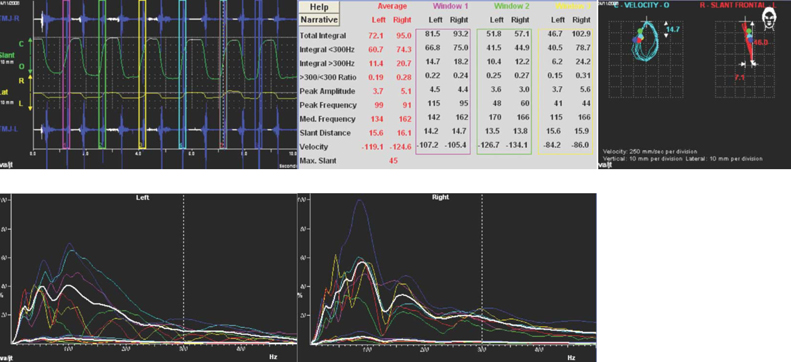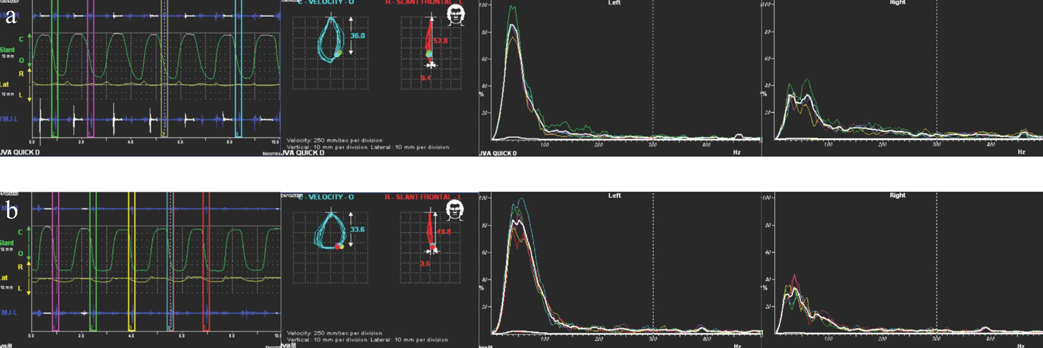J Adv Prosthodont.
2009 Mar;1(1):26-30. 10.4047/jap.2009.1.1.26.
Evaluation of TMJ sound on the subject with TMJ disorder by Joint Vibration Analysis
- Affiliations
-
- 1Department of Prosthodontics, College of Dentistry, Chosun University, Gwangju, Korea. DWKang@chosun.ac.kr
- KMID: 2176337
- DOI: http://doi.org/10.4047/jap.2009.1.1.26
Abstract
- STATEMENT OF PROBLEM: Qualitative and semi-quantitative methods have been developed for TMJ sound classification, but the criteria presented are completely inhomogeneous. Thus, to develop more objective criteria for defining TMJ sounds, electroacoustical systems have been developed. We used Joint vibration analysis in the BioPAK system (Bioresearch Inc., Milwaukee, USA) as the electrovibratography. PURPOSE: The aim of this study was to examine the TMJ sounds with repect to frequency spectra patterns and the integral > 300 Hz /< 300 Hz ratios via six-months follow-up. MATERIAL AND METHODS: This study was done before and after the six-months recordings with 20 dental school students showed anterior disk displacement with reduction. Joint vibrations were analyzed using a mathematical technique known as the Fast Fourier Transform. RESULTS: In this study Group I and Group II showed varied integral > 300 /< 300 ratios before and after the six-months recordings. Also, by the comparative study between the integral > 300 /< 300 ratios and the frequency spectrums, it was conceivable that the frequency spectrums showed similar patterns at the same location that the joint sound occurred before and after the six-months recordings. while the frequency spectrums showed varied patterns at the different locations that the joint sound occurred before and after six-month recordings, it would possibly be due to the differences in the degree of internal derangement and/or in the shape of the disc. CONCLUSIONS: It is suggested that clinicians consider the integral > 300 /< 300 ratios as well as the frequency spectrums to decide the starting-point of the treatment for TMJ sounds.
MeSH Terms
Figure
Reference
-
1. Okeson JP. Joint intracapsular disorders: diagnostic and nonsurgical management considerations. Dent Clin North Am. 2007. 51:85–103.2. Molinari F, Manicone PF, Raffaelli L, Raffaelli R, Pirronti T, Bonomo L. Temporomandibular joint soft-tissue pathology, I: Disc abnormalities. Semin Ultrasound CT MR. 2007. 28:192–204.3. Muhl ZF, Sadowsky C, Sakols EI. Timing of temporomandibular joint sounds in orthodontic patients. J Dent Res. 1987. 66:1389–1392.4. Rohlin M, Westesson PL, Eriksson L. The correlation of temporomandibular joint sounds with joint morphology in fifty-five autopsy specimens. J Oral Maxillofac Surg. 1985. 43:194–200.5. Taşkaya-Yilmaz N, Oğütcen-Toller M. Magnetic resonance imaging evaluation of temporomandibular joint disc deformities in relation to type of disc displacement. J Oral Maxillofac Surg. 2001. 59:860–865. discussion 865-6.6. McNeill CH. Science and practice of occlusion. 2000. Chicago: Quintessence.7. Eriksson L, Westesson PL, Rohlin M. Temporomandibular joint sounds in patients with disc displacement. Int J Oral Surg. 1985. 14:428–436.8. Watt DM, McPhee PM. An analysis of temporomandibular joint sounds. J Dent. 1983. 11:346–355.9. Oster C, Katzberg RW, Tallents RH, Morris TW, Bartholomew J, Miller TL, Hayakawa K. Characterization of temporomandibular joint sounds. A preliminary investigation with arthrographic correlation. Oral Surg Oral Med Oral Pathol. 1984. 58:10–16.10. Gale EN, Gross A. An evaluation of temporomandibular joint sounds. J Am Dent Assoc. 1985. 111:62–63.11. Watt DM. Temporomandibular joint sounds. J Dent. 1980. 8:119–127.12. Gay T, Bertolami CN. The spectral properties of temporomandibular joint sounds. J Dent Res. 1987. 66:1189–1194.13. Findlay IA, Kilpatrick SJ. An analysis of the sounds produced by the mandibular joint. J Dent Res. 1960. 39:1163–1171.14. Messenger KL, Barghi N. The effect of function and rest on the amplitude of the TMJ click. J Oral Rehabil. 1987. 14:261–266.15. Mohl ND, Lund JP, Widmer CG, McCall WD Jr. Devices for the diagnosis and treatment of temporomandibular disorders. Part II: Electromyography and sonography. J Prosthet Dent. 1990. 63:332–336.16. Gallo LM, Svoboda A, Palla S. Reproducibility of temporomandibular joint clicking. J Orofac Pain. 2000. 14:293–302.17. Ishigaki S, Bessette RW, Maruyama T. Vibration analysis of the temporomandibular joints with meniscal displacement with and without reduction. Cranio. 1993. 11:192–201.18. Ishigaki S, Bessette RW, Maruyama T. Vibration analysis of the temporomandibular joints with degenerative joint disease. Cranio. 1993. 11:276–283.19. Garcia AR, Folli S, Zuim PR, Sousa V. Mandible protrusion and decrease of TMJ sounds: an electrovibratographic examination. Braz Dent J. 2008. 19:77–82.
- Full Text Links
- Actions
-
Cited
- CITED
-
- Close
- Share
- Similar articles
-
- Analysis of the clinical symptoms and the temporomandibular joint disk by magnetic resonance imaging after conservative treatment with anterior repositioning splint
- A Case of Spontaneous Temporomandibular Joint Herniation into the External Auditory Canal with Clicking Sound
- Temporomandibular joint ankylosis in Williams syndrome patient: an insight on the function of elastin in temporomandibular joint disorder
- Traumatic TMJ injury
- A comparison of clinical symptoms and magnetic resonance images in temporomandibular joint disorders




